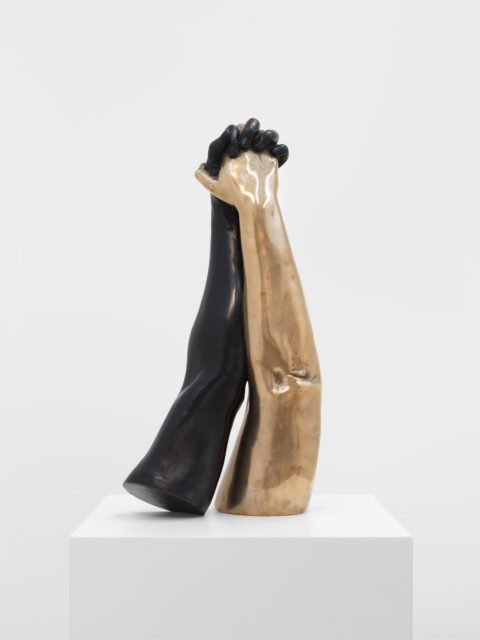Hank Willis Thomas’s solo exhibition We the People is currently on view in the Van Every and Smith Galleries, and this reflection explores one of several sculptures he created which highlights gesture. Like other smaller works in the exhibition, Loving Day, which Thomas created in 2022, is related to a larger work by the artist which shares the same title. In the large-scale version, each arm is carved in a different color marble. Here, however, Thomas differentiates the two arms with different finishes: one is black patina, while the other is polished bronze.
The gesture Thomas captures in this work symbolizes love and unity, and the piece references a couple who played a central role in creating a pivotal change via Supreme Court litigation.
The Lovings were a couple who married in 1958 in Washington, D.C., before moving back to Virginia. Richard Loving, a white man, and Mildred Loving, a Black woman, were convicted in 1959 of violating Virginia’s Racial Integrity Act of 1924, which criminalized interracial marriage. The couple was sentenced to one year in prison, though the sentence was suspended on the condition that they leave the state and not return for twenty-five years. The Lovings returned to D.C. and filed suit, arguing that the anti-miscegenation law violated the Equal Protection Clause of the Fourteenth Amendment.
The state of Virginia argued that no violation occurred because marriage regulation is in state policing power. However, because the law made a classification based on race, the Supreme Court applied strict scrutiny, under which a law must satisfy two conditions: the interest it intends to fulfill is compelling, and the law is narrowly tailored. The Court determined that the law was not narrowly tailored and was created with the goal of discrimination.
The Court also cited the Due Process Clause: the state cannot deprive anyone of life, liberty, or property without due process of law. The Court recognized that the right to marry is an essential component of individual autonomy key to underlying principles of the Due Process Clause.
Loving v. Virginia continues to have a profound impact. For example, the Court referenced the case in Obergefell v. Hodges, the 2015 case in which the Supreme Court affirmed that the fundamental right to same-sex marriage is guaranteed by the Due Process and Equal Protection Clauses of the Fourteenth Amendment. Additionally, June 12 marks the annual, unofficial celebration of “Loving Day,” honoring the day in 1967 that the Supreme Court overturned the couple’s conviction and invalidated all anti-miscegenation laws in the US, affirming the right of interracial couples to marry. Nonetheless, many states maintained such laws on their books symbolically until they were formally repealed, with Alabama being the last state to remove its law in the year 2000.
Thomas’ Loving Day memorializes the critical moment in litigation that Loving v. Virginia represents and cements its legacy through the visual language of connection, to which he adds depth through the contrasting materiality of the arms.
-Heidi McGannon ’26

Hank Willis Thomas, Loving Day, 2022. Black patina bronze and polished bronze. Courtesy of Jack Shainman Gallery.

